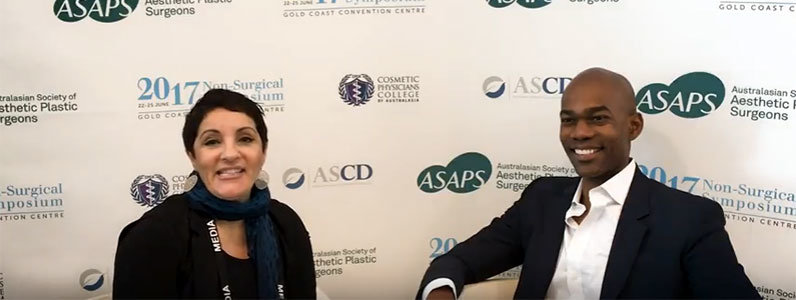
The Non-Surgical Symposium 2017 attracts plastic surgeons and practitioners from all over the world. I caught up with plastic surgeon Dr Julius Few from Chicago about body contouring, both surgical and non-surgical. If you are trying to figure out which is best for you listen to the podcast, watch the video or read below to find out more.
Trish: I’m here today, and I’m really excited because I’m talking to Dr. Julius Few, who’s a plastic surgeon based in Chicago. And we’re going to have a bit of a talk about the combination of nonsurgical and surgical modalities for body contouring.
Julius Few: It’s a topic that I love to talk about. So I’m happy to be here.
Trish: Great. So tell us a bit about … So how did the two work together … It’s not … ‘Cause I’ve had some body contouring procedures after losing a lot of weight. And I’ve actually done both the nonsurgical and surgical. So how do they work together? Why would one have both?
Julius Few: Well, as you know, having body contouring surgery … for a lot of the patients that we see, it can be a real challenge because the surgery downtime, the risk that maybe some of our patients don’t want to take. And a lot of patients actually come and say they just don’t want to have surgery or if they’re going to have surgery, they want it to be the bare minimum in terms of risk and recovery and all of the other kind of details that go with surgery.
So the way that I’ve kind of evolved over the last 15 years or more has really been kind of a progressive journey that I’ve had with my patients who, basically, have been very loyal and working and following with me.
And so, for example, patients who have started by doing a abdominoplasty, or tummy tuck … they got a good result. But as we know … I mean, for all of us … I mean, our weight goes up and down, like, fluctuates. This is reality. And so I will have people come back with a little bit of fat pooching out somewhere that they don’t like. But they ask, “Can we do something other than surgery?” And now, as the technology has continued to get better and better, the reality is we can use different modalities like cryolipolysis or a combination of both to really get, I think, a nice enhancement to what already would have been a good surgery.
Trish: I think the days are gone of you going to a plastic surgeon, having a … and then disappearing. Now we form that relationship and you go to have, well, pretty much everything done. You find who you align with, and then you go there and you have little tweaks here and there.
And so that’s exactly what I’ve done. I had an abdominoplasty. Then I had a bit of lipo. Then I had a bit of sculpture on the side just to sort of get that–
Julius Few: A hybrid.
Trish: Yeah. It’s never gonna be perfect, and I am a fluctuator.
Julius Few: Yeah. And this is the best of both worlds. I mean, the truth is that you want to have a relationship with the provider who has a good artistic eye but also has the ability to say, “Yes, this is a good choice for you,” or, “It’s not a good choice for you” and then to build the relationship that way. And I … the analogy that I like to use is it’s a lot like your house, your home. It would be foolish to think once you buy or rent your home, you will never think about doing anything to it ever again.
Trish: Exactly.
Julius Few: That’s not real.
Trish: No.
Julius Few: And so the truth is that as we put everything together … as we put everything together … I mean, overall, that’s the idea. It’s maintenance and protecting your investment. So in many cases, especially for body contouring, if you have someone who’s maybe even done liposuction but they’re … and I get this all the time. I have patients who say, “You know what? I’m going to have” — and they can be relatively young. And they’ll say, “Well, I’m really worried that after I have liposuction, I’m gonna have loose skin.” Well, we now have protocol where, once a year, we’ll do radiofrequency typing treatments to stimulate collagen, to keep the tissue tight, and it maintains their liposuction result. So the days of coming in and going are gone.
Trish: It’s all about maintenance and a certain level of —
Julius Few: And protecting your investment. And the truth is, in an application that has real benefit over time, it makes sense. Instead of five, ten years later, going back and saying, “I’m gonna have liposuction again.”
Trish: Or “I’m not happy with the result.”
Julius Few: “I’m not happy with the skin,” something like that.
Trish: That’s great. Well, good to hear, because that … I’m very much of that philosophy, so it’s really good that it’s actually what everyone’s putting out there as well.
Julius Few: Absolutely.
Trish: Well, thank you so much for that. Thank you.
Julius Few: Yeah.
Trish: So if you … if you’re having a procedure or you’ve got a doctor that you’ve got, try and make sure that they have nice aftercare. That’s the good thing about being in Australia … you’ll always get aftercare with your practitioner. So yeah. Any information, just drop us an email at [email protected]. Thank you so much.
Julius Few: Thank you.
